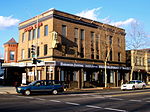Ben's Chili Bowl

Ben's Chili Bowl is a landmark restaurant in Washington, D.C., located at 1213 U Street, next to Lincoln Theatre, in the U Street Corridor (a.k.a. Cardozo/Shaw neighborhood) of Northwest D.C. It is known locally for its chili dogs, half-smokes, and milkshakes, and has been an integral part of the neighborhood's history since its founding in 1958. It was frequented by both police and protesters during the 1968 Washington, D.C. riots, and is regularly visited by celebrities, such as Anthony Bourdain and Chris Tucker. In January 2009, Washington, D.C. Mayor Adrian Fenty took then President-elect Barack Obama to eat at Ben's as part of his welcome to the city.
Excerpt from the Wikipedia article Ben's Chili Bowl (License: CC BY-SA 3.0, Authors, Images).Ben's Chili Bowl
Vermont Avenue Northwest, Washington
Geographical coordinates (GPS) Address Website Nearby Places Show on map
Geographical coordinates (GPS)
| Latitude | Longitude |
|---|---|
| N 38.9172 ° | E -77.0288 ° |
Address
Greater U Street Historic District
Vermont Avenue Northwest
20060 Washington
District of Columbia, United States
Open on Google Maps








